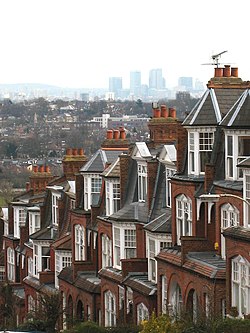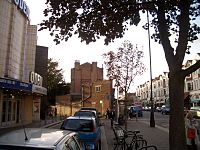Muswell Hill
| Muswell Hill | |
| Middlesex | |
|---|---|
 View looking south east | |
| Location | |
| Grid reference: | TQ287897 |
| Location: | 51°35’31"N, 0°8’35"W |
| Data | |
| Post town: | London |
| Postcode: | N10 |
| Dialling code: | 020 |
| Local Government | |
| Council: | Haringey, Barnet |
| Parliamentary constituency: |
Hornsey and Wood Green |
Muswell Hill is a suburban village in northern Middlesex, within the metropolitan conurbation. It is situated about six miles north of Charing Cross and from the City of London.
Although boundaries are hard to place in the continguous suburbs, Muswell Hill by a postcode definition had a recorded population of 27,992 at the 2011 Census.
History
[[File:Muswell hill broadway.jpg|left|thumb|200px|Muswell Hill Broadway The earliest records of Muswell Hill date from the 12th century. The Bishop of London, who was the Lord of the Manor of Haringey (Hornsey) owned the area and granted 65 acres to the east of Colney Hatch Lane, to a newly formed order of nuns. The nuns built a chapel on the site and called it Our Lady of Muswell.
The name Muswell is believed to come from a natural spring or well (the "Mossy Well"), said to have miraculous properties. A traditional story tells that Scottish king Malcolm IV was cured of disease after drinking the water. The area became a place of pilgrimage for healing during the Middle Ages. The story of King Malcolm might however have originated at Muswell Hill Manor in Oxfordshire, said to have been owned by the Kings of Scotland in the 12th century.
The River Moselle, which has its source in Muswell Hill and Highgate, derives its name from this district; it was originally known as the Mosa or Mosella.[1][2]
In the 18th century Muswell Hill was a scattered village consisting mainly of detached villas with large gardens.[3] In 1787 one commentator wrote that nowhere within a hundred miles of London was there a village so pleasant or with such varied views.[4] Little had changed by the middle of the 19th century. One of the houses of the time was The Limes. This house occupied the angle of Muswell Hill Road with Colney Hatch Lane and was a three-storeyed house with portico and two-storeyed wing approached by a double carriage drive through impressive gateways. The large grounds of the house extended to Tetherdown and included a lake.[5] Opposite The Limes was Muswell Hill pond and beyond that the Green Man inn, built of stone.[6]
Further down the hill past the Green Man was The Elms, a squat three-storeyed house later improved by Thomas Cubitt standing in 11 acres, part of the grounds of which were laid out by Joseph Paxton.[7] A short distance down the north side of Muswell Hill was The Grove, which was three storeys high and had nine bays with pedimented projections at each end.[8] It stood in eight acres of grounds which contained a 200-yard avenue of oaks. In 1774 the house was occupied by Topham Beauclerk.[9]
A little farther down the hill stood Grove Lodge, also in wooded grounds.[10] Altogether there were eight properties in Muswell Hill worthy of note in 1817.[11]

Parallel with Muswell Hill was a track known as St James's Lane which ran across a triangle of wasteland. By the middle of the 19th century houses were already dispersed along the lane at the foot of which was Lalla Rookh, a two-storeyed villa with a wide verandah.[12] Other buildings there were apparently cottages or huts, both single and in terraces.[13]
It was not until the end of the 19th century that Muswell Hill began to be developed more densely from a collection of country houses to the London village that it is today. The development was spurred by the opening in 1873 of Alexandra Palace, a massive pleasure pavilion built on the most easterly of north London's gravel hills and intended as the counterpart to the Crystal Palace on Sydenham Hill in south London. Alexandra Palace was served by a branchline railway from Highgate, with an intermediary station at Muswell Hill. The foot of Alexandra Palace was served by another rail network with connecting services to Finsbury Park and Kings Cross stations.
Most development was initiated in the early 20th century when the current street pattern was set out and elegant Edwardian retail parades were constructed. The shopping centre is based on roads that form three sides of a square: Fortis Green Road, Muswell Hill Broadway and the extension of the Broadway into Colney Hatch Lane. At each node point is a church: United Reformed, Church of England, Methodist, and Roman Catholic. One of the nodes, opposite St James's CoE, was also the site of the Athenaeum music hall (later demolished with the site redeveloped as a supermarket), opposite which a surviving art deco Odeon cinema was built in the 1930s. The site of the Ritz, a cinema formerly at the top of Muswell Hill on the next node to the east, has been redeveloped as offices.
Until the mid-20th century there was a rail branch line, the Muswell Hill Railway, from Highgate which passed through Muswell Hill, terminating at a station at Alexandra Palace. It was intended under the Northern Heights plan to integrate this into the London Underground Northern line; some contemporary tube maps showed the line as under construction. [14] However, this plan was cancelled after the Second World War, and the railway line was abandoned in 1954. The line was later converted to become the Parkland Walk.
In March 2013 Muswell Hill was named one of the five most desirable places to live in London in the Sunday Times "Best Places To Live" guide.
Geography
Close to Alexandra Park and Highgate Woods, Muswell Hill is a mainly Edwardian north London suburb. Muswell Hill Broadway and Fortis Green Road, the main shopping streets, still maintain their historic character with most of the original facades preserved above street level. The area has a synagogue and six churches, one of which has been converted into a pub. Some parts have fine views over London.
In popular culture
- In the war romance film The Americanization of Emily (1964), Emily's mother lives in a house in Dukes Avenue. Exterior shots show Alexandra Palace in the background.
- In the 1970s BBC TV comedy series Porridge, the principal character, Norman Stanley Fletcher, played by Ronnie Barker, hailed from Muswell Hill. Fletcher claimed that in his younger days he was "King of the Teds in Muswell Hill".
- Rock band the Kinks in 1971 recorded the LP Muswell Hillbillies, which included the song "Muswell Hillbilly".
- The TV sitcom That's My Boy (1981–1986), starring Mollie Sugden and Christopher Blake, made frequent references to Muswell Hill, as the family lived in the area throughout the first four seasons.
- Series one of the 1993 sitcom Sean's Show is set in Muswell Hill.[15]
- Parts of the film Shaun of the Dead (2004) were filmed in Muswell Hill.
- The Doctor Who episode "The Idiot's Lantern" (2006) was based around Muswell Hill, set during Queen Elizabeth II's coronation in 1953.
- The Muswell Hill Bookshop is featured in the film Tamara Drewe (2010).
References in literature
- There is reference to Muswell Hill in Samuel Richardson's Clarissa, published in 1748. Clarissa Harlowe and Robert Lovelace take a tour in a carriage from Highgate to Muswell Hill.
- In Hilaire Belloc's Cautionary Tales for Children, Charles Augustus Fortescue "... thus became immensely Rich, / And built the Splendid Mansion which / Is called The Cedars, Muswell Hill, / Where he resides in affluence still ..."
- "And utterly ruined the cook's nerves at Mr Brewer's establishment at Muswell Hill." – Mrs Dalloway, Virginia Woolf
- "A diamond," "A heart," "No trumps," "Two spades – / Happy and tense they played at Auction Bridge: / Two tables in the drawing-room of friends / From terra-cotta flats on Muswell Hill / and nearer Brookfield Mansions ..." – Summoned by Bells, 1960, John Betjeman
- Anthony Horowitz mentions Muswell Hill in Horowitz Horror.
- A Year In Muswell Hill by Pierre La Poste
Outside links
| ("Wikimedia Commons" has material about Muswell Hill) |
- Muswell Hill & Fortis Green Association - has some good historical pictures etc
References
- ↑ Albert Pinching & David Bell, Haringey's Hidden Streams Revealed, 2005
- ↑ Bedwell, Rev William (1561 - 1632): A Briefe Description of the Town of Tottenham Highcrosse in Middlesex (1631)
- ↑ Brewer, Beauties of Eng. & Wales, x (5), 213; Ambulator (1820)
- ↑ Ambulator (1787)
- ↑ J. Keane, Beauties of Mdx. (1850), 148-9; Hornsey libr., N. Mdx. Photo. Soc. no. 632.
- ↑ Postcard in Hornsey libr.
- ↑ B.L. Maps Dept., sales parts. (1880).
- ↑ A History of the County of Middlesex - Volume : {{{2}}} (Victoria County History)
- ↑ Keane, Beauties of Mdx. 239-41; Hornsey Hist. Soc. Bull. Sept. 1975; M.L.R. 1779/5/494; M.R.O., MR/DE Hornsey; Ambulator (1787 and later edns.)
- ↑ C. Nicholson, Scraps of Hist. of a Nethern. Suburb of Lond. (1879), 16; sales parts. (1939) in Hornsey libr.
- ↑ Hassell, Rides and Walks, i. 194.
- ↑ Thorne, Environs, 443-4.
- ↑ Photos. (1935) in Hornsey libr.; Hornsey Boro. Ann. Rep. of M.O.H. (1930); see also Sherington, Story of Hornsey, 42
- ↑ 1948 map
- ↑ "Sean's Show". Channel 4. http://www.channel4.com/programmes/seans-show/4od. Retrieved 9 August 2013.
